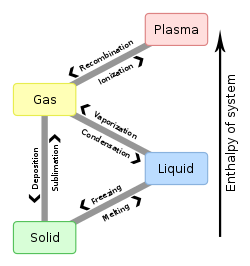User:Inconspicuum/Physics (A Level)/Heat and Energy
Matter is made of particles. These particles are constantly moving. When we feel some matter, we feel something that we call 'heat'. This is just our impression of how fast the particles are moving. The higher the average speed of the particles, the hotter something is.
Note that there is a technical difference between 'heat' and 'temperature'. Heat is energy in transit, also known as work. Temperature is the internal energy of a substance. We feel heat, not temperature, for if the energy did not move from an object, we would not be able to measure it.
If we had some matter which was made of stationary particles, then we would not be able to make the particles more stationary. The concept is meaningless. When matter is in this state, it is at the coldest temperature possible. We call this temperature 0°K. This corresponds to -273.15°C. If the temperature rises by 1°K, the temperature rises by 1°C. The only difference between the two scales is what temperature is defined as 0 - in Kelvin, 0 is absolute zero. In Celsius, 0 is the freezing point of water. In both scales, 1° is one hundredth of the difference in temperature between the freezing and boiling points of water.
Some matter of temperature T consists of many particles. Their motion is essentially random - they are all moving at different speeds, and so they all have different kinetic energies. The temperature is related to the average energy per. particle E by the following approximate relationship:
,
where k is a constant known as the Boltzmann constant. k = 1.38 x 10-23JK-1. T must always be measured in Kelvin.
Changes of State
[edit | edit source]
Different substances change state at different temperatures. In other words, when the average energy per. particle reaches a certain level, the substance changes state. The situation complicates itself since, in order to change state, additional energy is required (or is given out). When liquid water reaches its boiling point, it will stay at its boiling point until it has all changed into water vapour since the energy being taken in is being used to change state, instead of to increase the temperature of the water. The average energy per. particle required to change state can be approximated using the formula above, where T is the temperature at which the substance changes state.
Activation Energy
[edit | edit source]Many things have an activation energy. In order for a chemical reaction to start, for example, the average energy per. particle must reach a certain level. However, most of the time, chemical reactions start at a lower average energy per. particle than the activation energy. This is because there is always a chance that some particles have the required activation energy, since the particles are moving at random. If the reaction is exothermic (this means that it gives out heat, raising the average energy per. particle), then, once one reaction has happened, more of the particles have the activation energy, and so the reaction accelerates until all the reagants are used up. The activation energy can be related to the temperature of the substance using the formula E=kT.

